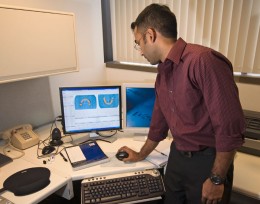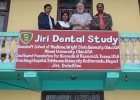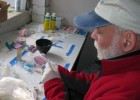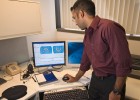
Mathew Thomas shows the automated system he developed for scanning and measuring dental casts for the Lifespan Health Research Center. Photo by Timothy R. Gaffney
((Contributed by Tim Gaffney))
Sometimes scientific research can seem as exciting as an Indiana Jones adventure. And sometimes it can be as tedious as watching paint dry.
A Wright State University professor’s quest for the genetic roots of facial defects has had elements of both, with journeys deep into Nepal to study the teeth and jaws of a remote population in the Himalayas.
For the past few years, Richard J. Sherwood, Ph.D., has been traveling to Jiri, a village literally at the end of the road from Kathmandu and just 40 miles from the base camp for Mount Everest climbing expeditions.
Sherwood, director of the Lifespan Health Research Center in the Boonshoft School of Medicine’s Department of Community Health, helped set up a small clinic in Jiri where a local dentist gives villagers a teeth cleaning and check-up — the first ever for most — and makes impressions of their teeth for Sherwood’s studies.
The work yields hundreds of dental casts each year. Sherwood fetches them himself, bringing back the science treasure carefully packed in metal trunks to avoid the risk of damage by commercial shippers. The trip includes a wild bus ride on a narrow mountain road with breathtaking views and even more breathtaking drop-offs.
That’s the exciting part. The tedious part is gathering data from the impressions. The traditional method is to make casts from the impressions and use calipers to take several measurements of every tooth — hundreds of casts, thousands of teeth, many thousands of measurements.
After an initial pilot study that produced 200 sets of impressions, Sherwood looked for a way to automate the process. He wanted not only to save time, but to gather certain data he couldn’t get with calipers — the surface area of a misshapen molar, for example, or how much a crowded tooth has turned.
“I realized that with an automated program you can take some measurements that you can’t take accurately by hand,” Sherwood said.
Last year he turned to the Department of Biomedical, Industrial and Human Factors Engineering and found help from Julie Skipper, Ph.D., currently a research associate professor with the Wright State Research Institute. Medical imaging is her specialty and one of the research capabilities that WSRI can bring to bear on the challenges facing academic, business and government researchers.
One of Skipper’s graduate students, Mathew Thomas, tackled Sherwood’s problem for his master’s thesis. Thomas developed a computerized system to scan the casts and then take multiple measurements of every tooth, as well as measurements of the whole structure. A grant from the National Institute of Dental and Craniofacial Research, a part of the National Institutes of Health, funded the project.
With his system, Thomas can scan and measure the teeth in a pair of casts in less than 10 minutes. “It’s been phenomenal,” Sherwood said. The results were so impressive that he hired Thomas full time to work on the project even as he finishes his thesis.
Why go to Nepal to measure teeth?
Sherwood is looking for clues to the genetic causes of deformities in the human face, including the teeth and jaw — such as cleft lips and cleft palates, among the most common human birth defects. For that he needs to gather data from a population that isn’t too diverse and whose ancestries have been mapped.
“The Jirel are interesting because everybody in the population is somehow related and can be traced back to a founding population that’s about 11 generations old,” he said.
What’s more, they all eat largely the same diet — and almost none have had crowns, fillings or other tooth-altering work. “If you’ve had orthodontic work, you’re disqualified from this study. In the United States, 30 to 40 percent of adults have had some kind of orthodontic work,” Sherwood said.
Other scientists laid the epidemiological groundwork in Jiri years ago. This has made the Jirel a popular study group for scientists, including others from Wright State. “The Jiri population is the most powerful population in the world for genetic epidemiological work,” Sherwood said.
The Lifespan Health Research Center studies the changes that happen to people throughout their lives. It’s the home of the Fels Longitudinal Study, the world’s largest and longest running study on human growth and body composition.
The Wright State Research Institute is a university organization that taps Wright States capabilities, researchers, scientists and staff to solve difficult problems facing its industry and government partners.
- Richard J. Sherwood, Ph.D., with others in Jiri, Nepal. Photo courtesy Richard J. Sherwood.
- Richard J. Sherwood, Ph.D., examines a dental impression in the Jiri Dental Study lab in Jiri, Nepal. Photo courtesy Richard J. Sherwood.
- Mathew Thomas shows the automated system he developed for scanning and measuring dental casts for the Lifespan Health Research Center. Photo by Timothy R. Gaffney




 Bags, boards and bonding
Bags, boards and bonding  More than 1,000 students to graduate at Wright State’s fall commencement ceremonies
More than 1,000 students to graduate at Wright State’s fall commencement ceremonies  Wright State’s Take Flight Program helps students soar high
Wright State’s Take Flight Program helps students soar high  Wright State Police Department delivers major donation to Raider Food Pantry
Wright State Police Department delivers major donation to Raider Food Pantry  Wright State engineering and computer science students earn prestigious federal SMART Scholarships
Wright State engineering and computer science students earn prestigious federal SMART Scholarships 